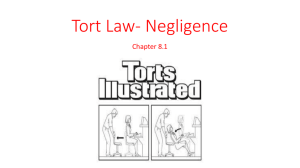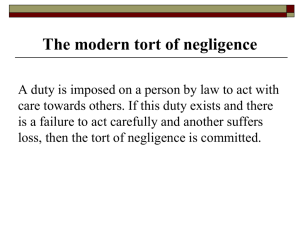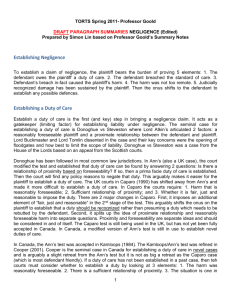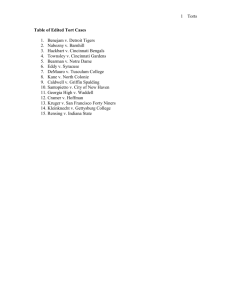PEL caused by Neglient Misrepresentation
advertisement
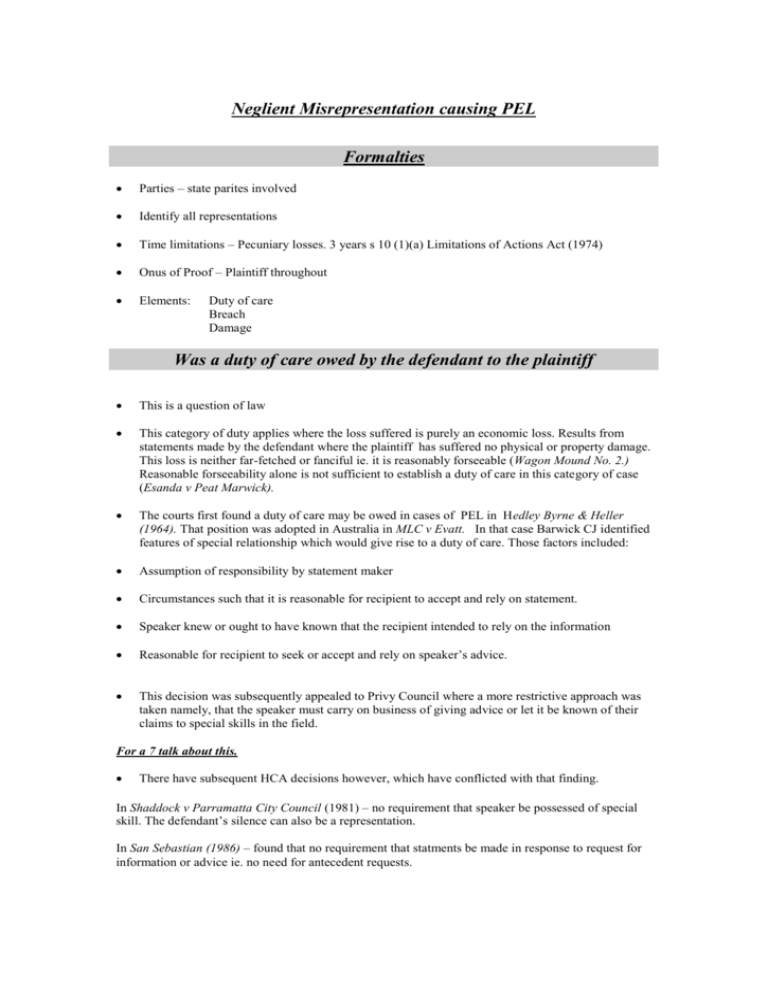
Neglient Misrepresentation causing PEL Formalties Parties – state parites involved Identify all representations Time limitations – Pecuniary losses. 3 years s 10 (1)(a) Limitations of Actions Act (1974) Onus of Proof – Plaintiff throughout Elements: Duty of care Breach Damage Was a duty of care owed by the defendant to the plaintiff This is a question of law This category of duty applies where the loss suffered is purely an economic loss. Results from statements made by the defendant where the plaintiff has suffered no physical or property damage. This loss is neither far-fetched or fanciful ie. it is reasonably forseeable (Wagon Mound No. 2.) Reasonable forseeability alone is not sufficient to establish a duty of care in this category of case (Esanda v Peat Marwick). The courts first found a duty of care may be owed in cases of PEL in Hedley Byrne & Heller (1964). That position was adopted in Australia in MLC v Evatt. In that case Barwick CJ identified features of special relationship which would give rise to a duty of care. Those factors included: Assumption of responsibility by statement maker Circumstances such that it is reasonable for recipient to accept and rely on statement. Speaker knew or ought to have known that the recipient intended to rely on the information Reasonable for recipient to seek or accept and rely on speaker’s advice. This decision was subsequently appealed to Privy Council where a more restrictive approach was taken namely, that the speaker must carry on business of giving advice or let it be known of their claims to special skills in the field. For a 7 talk about this. There have subsequent HCA decisions however, which have conflicted with that finding. In Shaddock v Parramatta City Council (1981) – no requirement that speaker be possessed of special skill. The defendant’s silence can also be a representation. In San Sebastian (1986) – found that no requirement that statments be made in response to request for information or advice ie. no need for antecedent requests. In Australia then it would not seem necessary to prove the existence of an antecedent request or that the speaker was in the business of providing advice. This approach was confirmed when the HCA applied the reasoning of Barwick in Tepko Pty Ltd v Water Board However, since the decision of the court in Sullivan & Moody what can be seen is that there is no one best test. Each case must be considered on its facts ie. each case will turn on its own facts. Then we come to applying the facts 1. Firstly, identify all representations. 2. Secondly, identify relationship between the plaintiff and the defendant (remember a professional relationship implies reasonable rliance). 3. Thirdly, apply the representations to the factors outlined above. 4. In conclusion determine whether a duty was owed. Remember the words of Glass J “this is a reasonable undemanding test.” Breach of Duty This is a question of fact. Standard required is an objective standard – Glasgow Corporation v Muir ie. that of a reasonable/competent person. In determining whether standard has been breached look at the two questions outlined in Wyong Shire Council v Shirt: 1. 2. Is the risk of damage forseeable? (Most risks are forseeable) What would a reasonable person do in response to the risk? Question: A reasonable person in the positon of the defendant would have done …. The defendant’s conduct has/hasn’t breached that standard. Damage Pure economic loss has been recognised at law (Hedley Byrne). Did defendant’s breached duty cause the plaintiff’s economic loss? Apply an appropriate causation test: 1. 2. 3. But for – Cork v Kirby McLean; Materially contributed to – Medelin v SGIO Common sense and experience – March v Stramere. Damage is not to remote if it is reasonably forseeable – Wagon Mound No. 2 Is plaintiff of a forseeable class and the damage of a forseeable kind? Defences Probably won’t be any but consider contributory negligence and joint illegal enterprise. Remedies Compensatory damages Damages for lost opportunity – Gates v City Mutual Life Assurance Society Ltd Must consider alternative Actions namely, s 52 TPA & Fraudlent Misrepresentation – templates for both these areas are separate.







